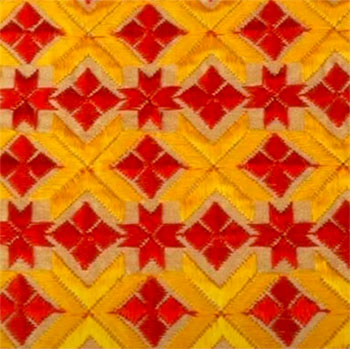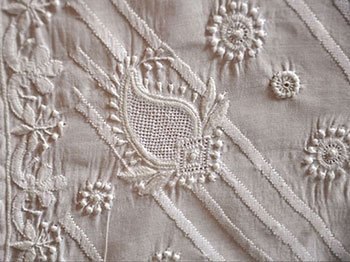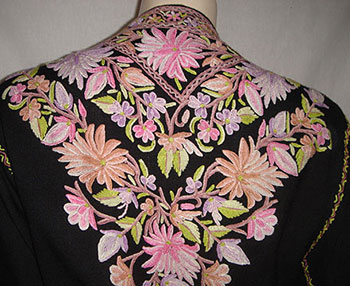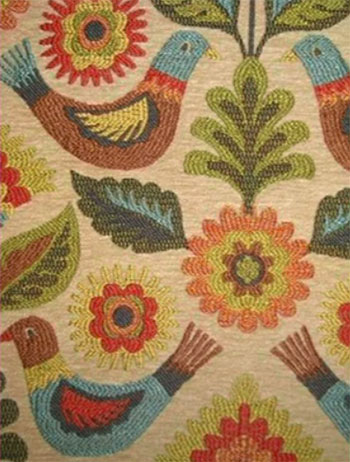 Indian traditional culture estimates embroidery highly. A lot of clothes and household items are usually decorated with needlework. Just look at Indian sarees, festive sherwani, and choli blouses and you’ll notice a variety of decorative techniques used to embellish these garments. There are dozens of different embroidery techniques and stitches used in India, but these 4 types of Indian needlework are among the most popular and beautiful – phulkari, chikankari, kashida, and kantha embroidery.
Indian traditional culture estimates embroidery highly. A lot of clothes and household items are usually decorated with needlework. Just look at Indian sarees, festive sherwani, and choli blouses and you’ll notice a variety of decorative techniques used to embellish these garments. There are dozens of different embroidery techniques and stitches used in India, but these 4 types of Indian needlework are among the most popular and beautiful – phulkari, chikankari, kashida, and kantha embroidery.
There are 4 most popular types of Indian folk embroidery:
- phulkari embroidery;
- chikankari needlework;
- kashida embroidery;
- kantha needlework.
Phulkari embroidery
Phulkari embroidery technique originates from Punjab state of India. Literally, the word “phulkari” means “flower work”, and we really see intricate flowers and floral motifs stitched on the fabric. But this technique isn’t entirely floral – some of the symbols resemble flowers more than others, there are also geometrical shapes, and many more. This embroidery style is very popular for Indian clothing.

Traditionally, the phulkari embroidery is done with colorful and shiny silk thread (red, yellow, green, orange, etc) on coarse cotton cloth called “khaddar”. Khaddar is a handwoven cotton fabric dyed with natural pigments. This fabric is typically made in 4 colors: white for elderly women and widows, red for young women, black and blue for everyday shawls worn by different females.
The stitches used in phulkari embroidery are darning stitch (most often), running stitch, herringbone stitch, buttonhole stitch, and some others. What’s interesting about this needlework technique is that the pattern is embroidered from the back of the fabric – you hold the cloth when embroidering so that you’re facing the back and then turn it over to see the ornamentation that appeared there.
Indian phulkari embroidery looks very cheerful, bright, and pretty.
Chikankari needlework
This embroidery technique originates from Uttar Pradesh state of India. It is very delicate needlework, often resembling whitework. Chikankari embroidery is not always white on white, sometimes it is made with colorful thread, but usually, it’s white embroidery floss on white cotton fabric. The chikankari style of embroidery is perfect for thin semi-transparent cotton fabric, it adds charm and sophistication to clothes. But cotton is not the only type of cloth fit for this technique – chikankari needlework can be created on silk, crepe, chiffon, georgette, etc.

Specific stitches are used in chikankari embroidery that are traditional for India. They’re called “bakhia” (similar to the herringbone stitch), “murri” (similar to french knot), “jali”, “tepchi” (a kind of the running stitch), “phanda” (another french knot style), etc.
This type of Indian embroidery is typically floral or with paisley motifs that are popular in India. It creates very beautiful and stylish decorations for clothing.
Kashida embroidery
This needlework technique originates from Kashmir state of India. It is one of the oldest embroidery styles in this area. Kashida embroidery has a nice texture and volume, it is raised above the fabric.
Usually, this stitching is made on thicker fabrics, including wool and various mixed fabrics. For example, it can be outerwear, cushions, light blankets, bedsheets, and even rugs. This needlework technique is good for colorful fabrics.

The threads used in kashida embroidery are diverse – wool, silk, cotton.
Among the most typical stitches are satin stitch, stem stitch, chain stitch, darning stitch, etc. The motifs are inspired by nature – flowers, animals, plants, food, etc.
Kantha needlework
This embroidery style originates from the western Bengal state of India. We can find this needlework on the local women’s sarees. Also, the Kantha embroidery technique is great for large pieces of clothing and linens – shawls, tablecloths, bedsheets, light blankets, etc. That’s because this technique helps cover large areas quickly.
Kantha needlework is typically done with colorful thick cotton thread. Among the most widespread colors are red, green, white, blue, yellow, and black.
As the fabric is densely covered with embroidery, people often reuse old pieces of cloth to create new items. For example, if the fabric has lost its vibrant colors after many washings, you can cover it with needlework and make it look new and pretty again. This is so useful for poorer people.

The traditional stitches used in kantha needlework are running stitch, satin stitch, darning stitch, loop stitch, etc. Sometimes the ornamentation or embroidered shapes are just outlined, without being fully covered with threads. This helps save the embroidery floss.
Kantha needlework is characterized by the motifs used to create the patterns. Very often, the work is a whole scene recreated on the fabric, not just a repetitive strip of embroidery, like other types of needlework show. Using kantha embroidery, you can tell a story and depict a lot of various animals, birds, people, plants, fish, mythological and mystical creatures, and so on.


